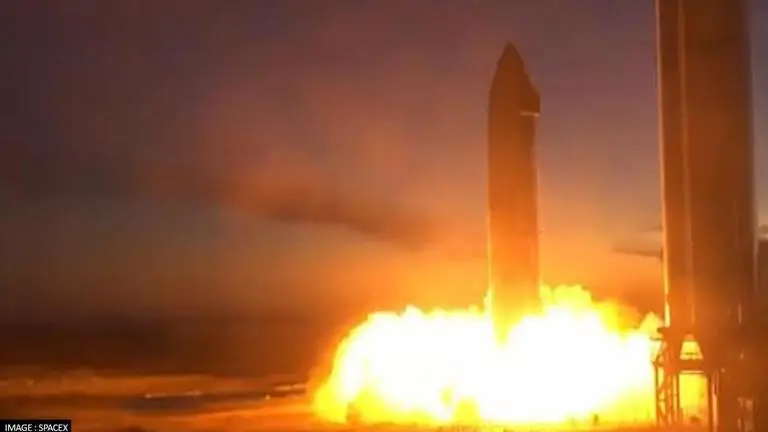Updated 22 October 2021 at 17:11 IST
SpaceX's Starship completes first vacuum raptor static fire test; Watch here
SpaceX's Starship SN20 was brought to life in a vacuum engine static fire test that was conducted at its Starbase facility, near South Texas.
- Tech News
- 2 min read

SpaceX's Starship SN20 was brought to life in a vacuum engine static fire test that was conducted at SpaceX's Starbase facility, in Boca Chica near South Texas on October 22. Touted as the future martian vehicle, the 165-foot-tall Starship is undergoing tests with a raptor vacuum engine ahead of its upcoming test flight later this year. According to Space.com, the SN20 is currently outfitted with two engines where one is the vacuum version, while the other is a standard "sea-level" raptor, however, only the former was fired in this test.
The company confirmed the development in a tweet sent out following the test in what was SpaceX's first trial of a vacuum raptor integrated on the future Martian vehicle.
Check out the tweet here:
First firing of a Raptor vacuum engine integrated onto a Starship pic.twitter.com/uCNAt8Kwzo
— SpaceX (@SpaceX) October 22, 2021
Starship's fate
Starship is SpaceX's most ambitious project to date as the Elon Musk-owned entity wants to use it to send humans and cargo to Mars using this vehicle. In fact, Starship has already been selected by NASA for the latter's Artemis mission as the first crewed lunar landing system.
The massive space vehicle is scheduled for a large-scale orbital flight later this year that will lift off with the Super Heavy booster powered by 29 raptors, the space news website reported. The SN20 is made of two components, the Starship spacecraft and the Super Heavy booster that will push the spacecraft to orbit. This will reportedly be Starship's longest flight till now. SpaceX has only conducted test launches to a maximum altitude of 10 kilometres.
Advertisement
Starship = the possibility of going to Mars becomes a possibility. 📸@astrodeven pic.twitter.com/1eNgsT3zdq
— Tesla Silicon Valley Club (@teslaownersSV) October 16, 2021
SpaceX is reportedly planning the launch soon once the US Federal Aviation Administration (FAA) clears SpaceX after conducting an environmental assessment of the launch site. Meanwhile, SpaceX has another launch, which is the Crew-3 mission, that will carry NASA astronauts to and fro the International Space Station (ISS).
Crew-3 mission
Raja Chari, an Indian-born NASA astronaut, will be leading the SpaceX-NASA collaborative Crew-3 mission that has been announced to take off on October 31. Chari will be accompanied by Tom Marshburn, pilot, and Kayla Barron, mission specialist as well as ESA (European Space Agency) astronaut Matthias Maurer. Currently, the astronauts are under quarantine as part of final preparations for the rotation mission, which will carry Crew-3 astronauts to the ISS and bring back Crew-2 astronauts from outer space.
Advertisement
(Image: @SpaceX/Twitter)
Published By : Harsh Vardhan
Published On: 22 October 2021 at 17:11 IST
